
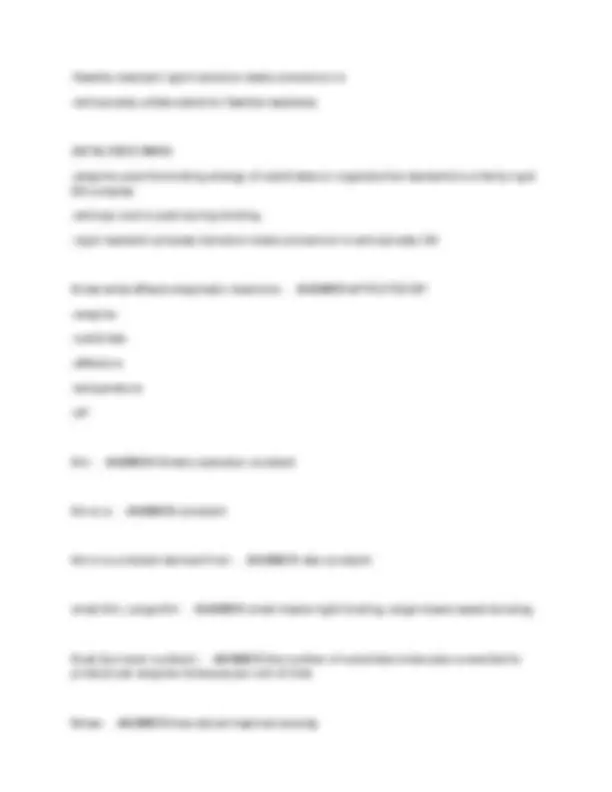
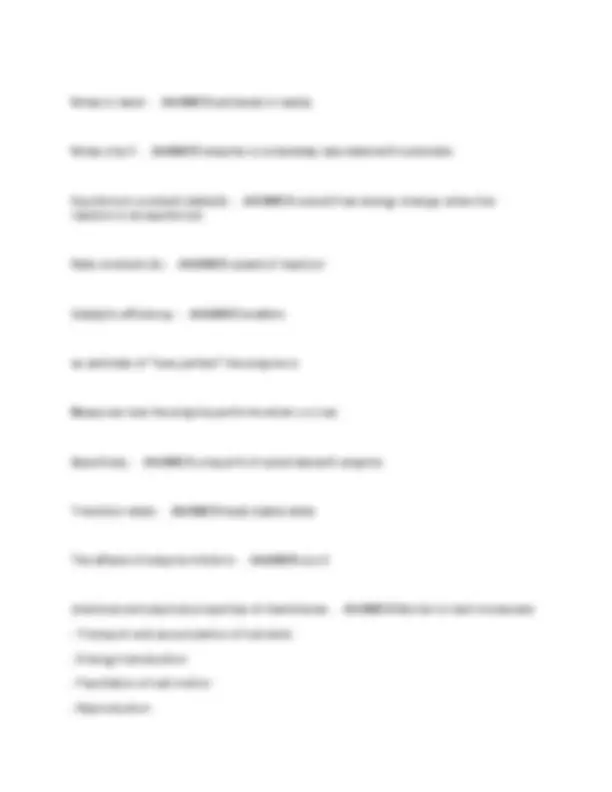
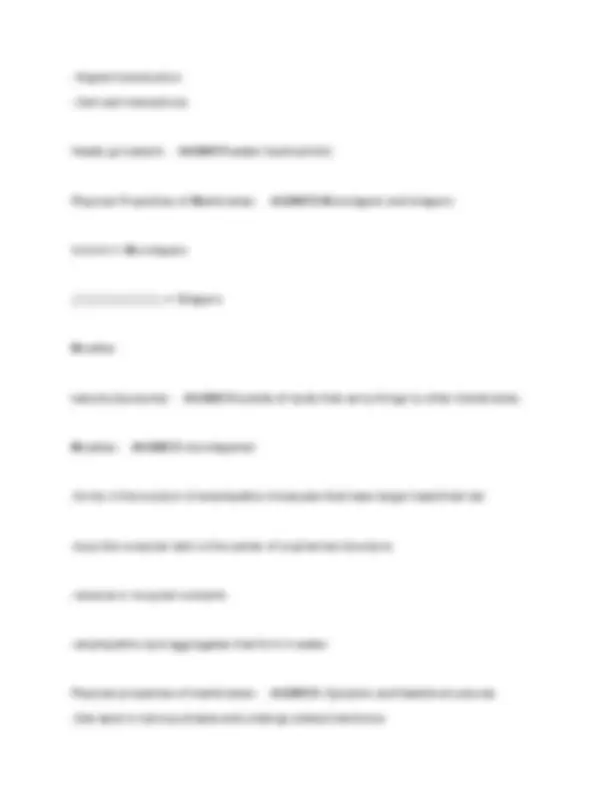
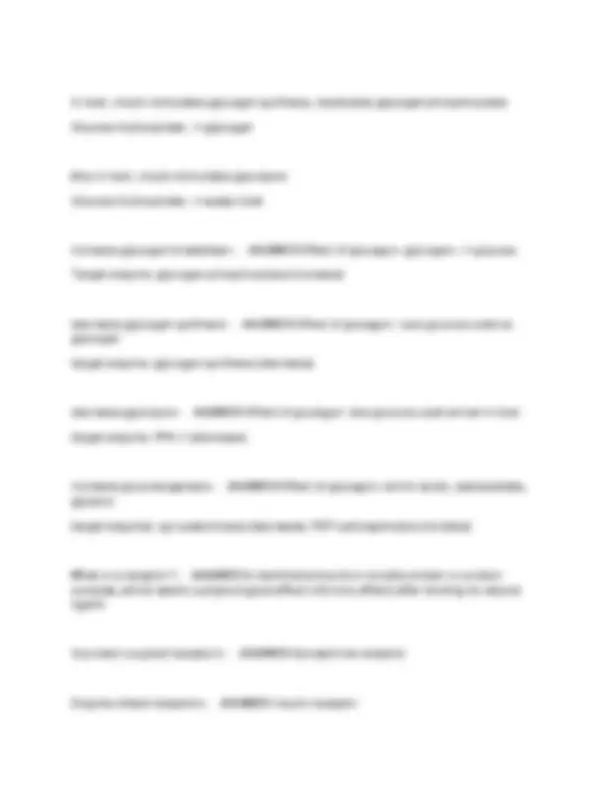
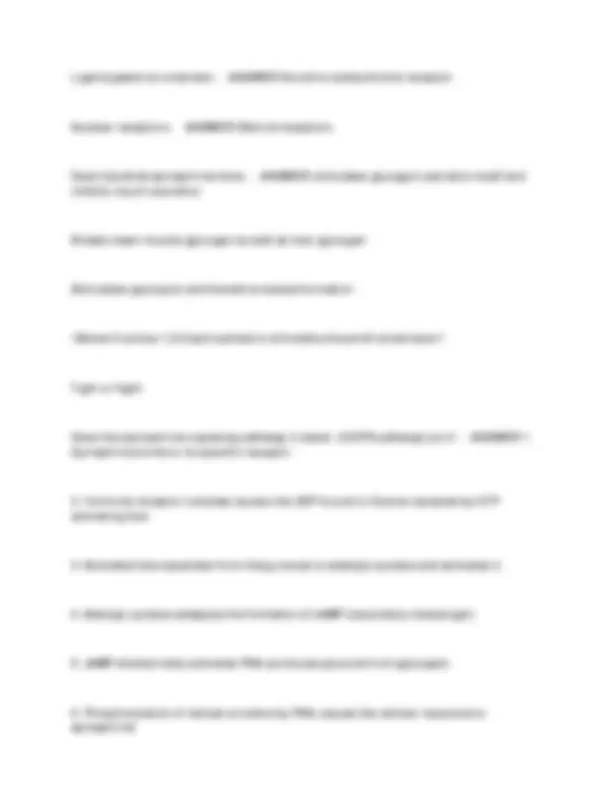
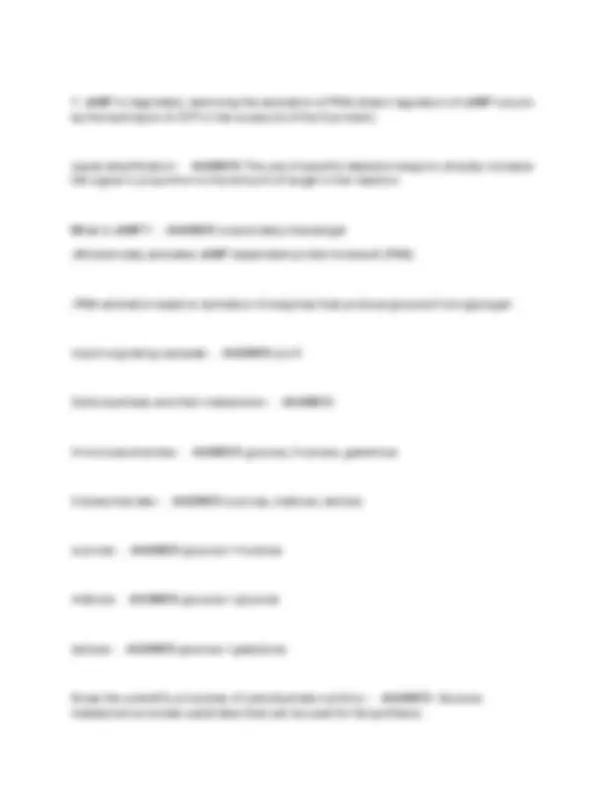
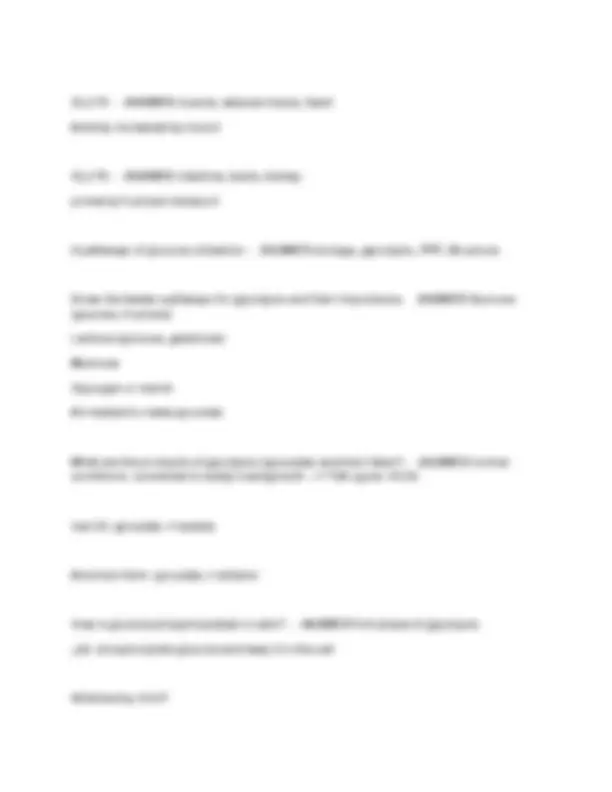
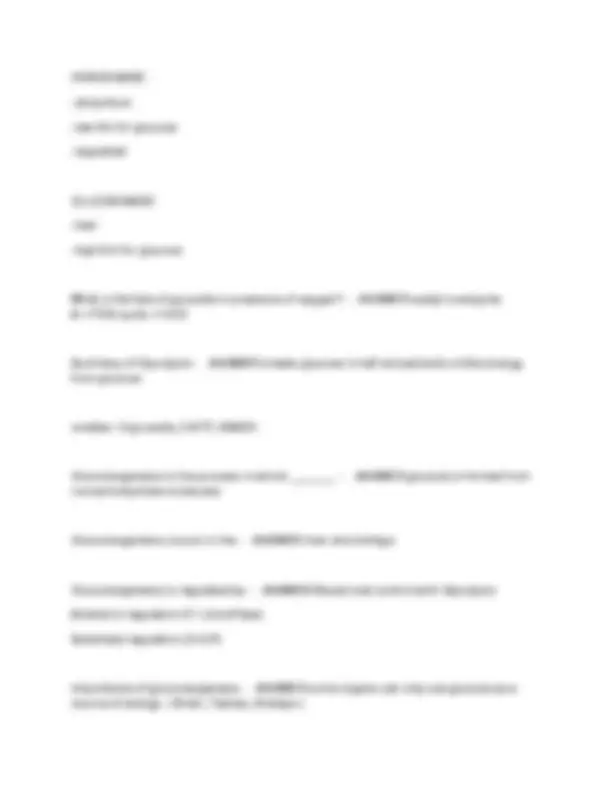
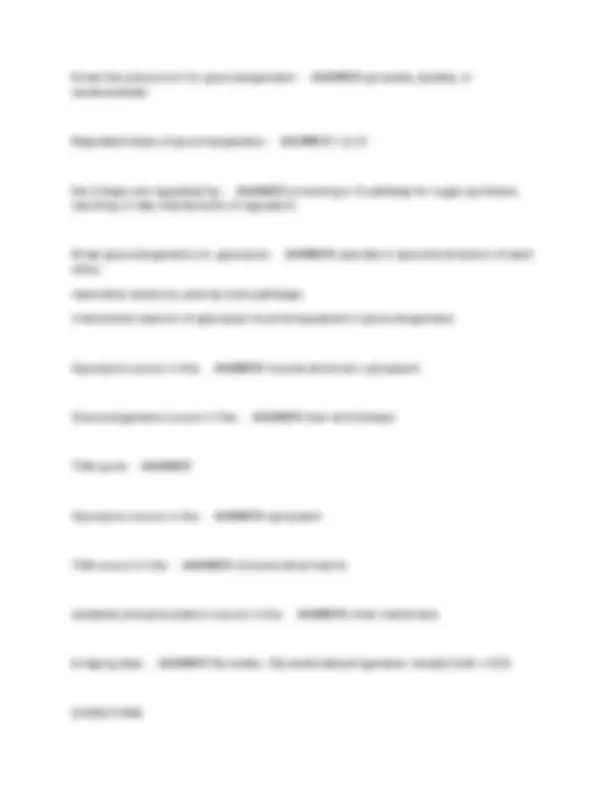
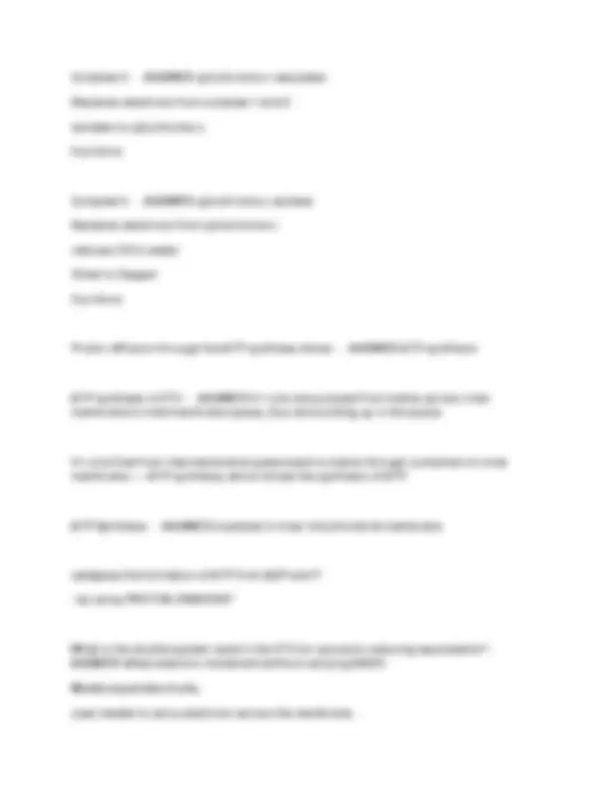
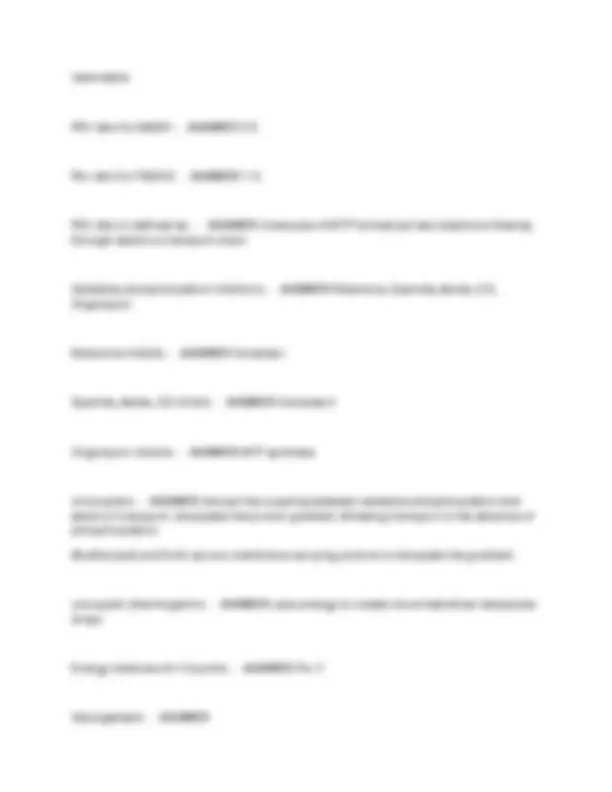
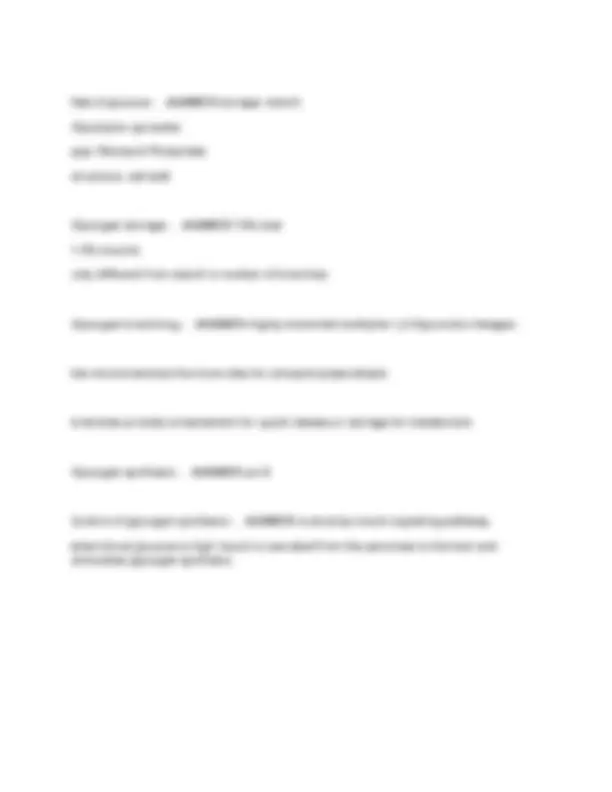


Study with the several resources on Docsity

Earn points by helping other students or get them with a premium plan


Prepare for your exams
Study with the several resources on Docsity

Earn points to download
Earn points by helping other students or get them with a premium plan
Community
Ask the community for help and clear up your study doubts
Discover the best universities in your country according to Docsity users
Free resources
Download our free guides on studying techniques, anxiety management strategies, and thesis advice from Docsity tutors
This study guide provides a comprehensive overview of key concepts related to enzymes, membranes, and hormones, covering topics such as enzyme kinetics, membrane structure and function, and hormone signaling pathways. It includes detailed explanations, diagrams, and examples to aid in understanding these fundamental biological processes. The guide is particularly useful for students preparing for ns 4320 exam 1 at ttu.
Typology: Exams
1 / 20

This page cannot be seen from the preview
Don't miss anything!













Enzymes and membranes - ANSWER What are enzymes? -up. ANSWER Catalysts. Increase reaction rates without being used
How do enzymes speed up chemical reactions? - ANSWER lower activation energy 6 classes of enzymes -isomerases, ligases ANSWER oxidoreductases, transferases, hydrolases, lysases,
Oxidoreductases - ANSWER transfer of electrons (H atoms) Transferases - ANSWER group transfer reactions Hydrolases - ANSWER Hydrolysis reactions (transfer of functional groups to water) Lyases -removal of groups ANSWER addition of groups to double bonds, or formation of double bonds by
Isomerases - ANSWER Transfer of groups within molecules to yield isomeric forms Ligases -reactions coupled to cleavage of ATP or similar cofactor ANSWER formation of C-C, C-S, C-O, and C-N bonds by condensation
Role of enzymes and their kinetics -(ex. cellular respiration/glucose breakdown) (G<0) ANSWER Exergonic: net release of free energy
Endergonic: energy is absorbed in the reaction (ex. photosynthesis) (G>0) Draw change in energy with and without enzyme. -state in lower. ANSWER Pic 1. Catalyzed transition
Enzymes act by - ANSWER binding substrates Enzymes _________ recognize proper substrates - ANSWER selectively Enzymes produce products in - ANSWER very high yields (greater than 95%) Specificity is controlled by - ANSWER structure Enzymes do not effect - ANSWER equilibrium (G) *The overall free energy change for a reaction is related to (G) -equilibrium constant ANSWER the
*The free energy of activation for a reaction is related to the (G++) -constant (k) ANSWER rate
catalyzed vs. uncatalyzed --two free reactants single restricted transition state ANSWER UNCATALYZED BIMOLECULAR RXNS -conversion is entropically unfavorable UNCATALYZED UNIMOLECULAR RXNS
Vmax is never - ANSWER achieved in reality Vmax only if - ANSWER enzyme is completely saturated with substrate Equilibrium constant (deltaG) -reaction is at equilibrium ANSWER overall free energy change; when the
Rate constant (k) - ANSWER speed of reaction Catalytic efficiency - ANSWER kcat/km an estimate of "how perfect" the enzyme is Measures how the enzyme performs when s is low. Specificity - ANSWER unique fit of substrate with enzyme Transition state - ANSWER least stable state The effects of enzyme ihibitors - ANSWER pic 2 chemical and physical properties of membranes - ANSWER Barrier to toxin molecules
-individual molecules CAN move around Hormones and signal transduction - ANSWER 3 classes of mammalian hormones -space, diffuse to neighboring target (ex. eicosanoids) ANSWER 1. paracrine: released into extracellular
cytosolic Ca2+ is now high enough to trigger insulin release by exocytosis Know about the effects of key hormones in metabolism - ANSWER What are some metabolic effects of insulin and the enzymes it targets? -Insulin stimulates glucose uptake in muscle and fat ANSWER Glucose --> glucose 6-phosphate
In liver, insulin stimulates glycogen synthase, inactivates glycogen phosphorylase Glucose 6-phosphate --> glycogen Also in liver, insulin stimulates glycolysisGlucose 6-phosphate --> acetyl-CoA
increase glycogen breakdown -Target enzyme: glycogen phosphorylase (increase) ANSWER Effect of glucagon: glycogen---> glucose
decrease glycogen synthesis -glycogen ANSWER Effect of glucagon: Less glucose used as target enzyme: glycogen synthase (decrease) decrease glycolysis - ANSWER Effect of glucagon: less glucose used as fuel in liver target enzyme: PFK-1 (decrease) increase gluconeogenesis -glycerol ANSWER Effect of glucagon: amino acids, oxaloacetate, target enzymes: pyruvate kinase (decrease); PEP carboxykinase (increase) What is a receptor? -complex, which exerts a physiological effect (intrinsic effect) after binding its natural ANSWER A membrane-bound or soluble protein or protein ligand. G-protein coupled receptors - ANSWER Epinephrine receptor Enzyme-linked receptors - ANSWER Insulin receptor
signal amplification -the signal in proportion to the amount of target in the reaction. ANSWER The use of specific detection ways to directly increase
What is cAMP? --Allosterically activates cAMP-dependent protein kinase A (PKA) ANSWER a secondary messenger
-PKA activation leads to activation of enzymes that produce glucose from glycogen insulin-signaling cascade - ANSWER pic 5 Carbohydrates and their metabolism - ANSWER 3 monosaccharides - ANSWER glucose, fructose, galactose 3 disaccharides - ANSWER sucrose, maltose, lactose sucrose - ANSWER glucose + fructose maltose - ANSWER glucose + glucose lactose - ANSWER glucose + galactose Know the scientific principles of carbohydrate nutrition -metabolism provides substrates that can be used for fat synthesis. ANSWER -Glucose
-Acetyl-CoA -->Fatty acids -->Triglycerides -Glycerol-3-phosphate --> Triglycerides Conversion of excess glucose to fat Glucose is one of two signals that stimulate the expression of genes for lipogenicenzymes, such as acetyl-CoA carboxylase and fatty acid synthase.
Serves as a glucose sensor - ANSWER Glucokinase CHO digestion mouth -starch and glycogen to disacharides ANSWER Begins in mouth with salivary amylase breaks down
CHO small intestine -disaccharides into monosacchiride. ANSWER continues in pancreas with pancreatic amylase,breaks
ends in small intestine with "brush border" enzymes -ASE - ANSWER Breaks things down. Maltase, Sucrase, Lactase. CHO absorption -the GI epithelial cells to enter blood and lymph. ANSWER is the process by which molecules are transported through
Glucose / Galactose is absorbed by - ANSWER SGLT Fructose is absorbed by - ANSWER GLUT
GLUT4 - ANSWER muscle, adipose tissue, heart Activity increased by insulin GLUT5 -primarily fructose transport ANSWER intestine, testis, kidney;
4 pathways of glucose utilization - ANSWER storage, glycolysis, PPP, Structure Know the feeder pathways for glycolysis and their importance -(glucose, fructose) ANSWER Sucrose Lactose (glucose, galactose) Mannose Glycogen or starchAll needed to make pyruvate
What are the products of glycolysis (pyruvate) and their fates? -conditions: converted to acetyl coenzyme A ---> TCA cycle-->CO2 ANSWER normal
low O2: pyruvate--> lactate Alcoholic ferm: pyruvate--> ethanol How is glucose phosphorylated in cells? - ANSWER first phase of glycolysis -job: phosphorylate glucose and keep it in the cell INhibited by G-6-P
-ubiquitous -low Km for glucose-regulated
GLUCOKINASE: -liver -high Km for glucose What is the fate of pyruvate in presence of oxygen? -A-->TCA cycle--> CO2 ANSWER acetyl coenzyme
Summary of Glycolysis -from glucose ANSWER breaks glucose in half and extracts a little energy
creates: 2 pyruvate, 2 ATP, 2NADH Gluconeogenesis is the process in which ________. -noncarbohydrate molecules ANSWER glucose is formed from
Gluconeogenesis occurs in the - ANSWER liver and kidneys Gluconeogenesis is regulated by -Allosteric regulation (F-1,6-bisPase) ANSWER Reciprocal control with Glycolysis Substrate regulation (G-6-P) Importance of gluconeogenesis -source of energy. ( Brain, Testies, Kidneys.) ANSWER some organs can only use glucose as a
-CoASH -lipoic acid-FAD -NAD+ What are the regulated steps of the TCA cycle? How are they regulated? -PDH, citrate synthase, Isocitrate dehydrogenase, and α-ketoglutarate dehydrogenase ANSWER
When ATP is low, .... (CAC) - ANSWER citric acid cycle is stimulated --> produces ATP When ATP is high, ... (CAC) - ANSWER Citric acid cycle is inhibited Acetyl-CoA is used for fatty acid synthesis instead of entering CAC 3 irreversible reactions mediated by ______________, ______________, and__________________ - ANSWER citrate synthetase, Isocitrate dehydrogenase,and α-ketoglutarate dehydrogenase
regulated by ATP or NADH
1 NADH produces ______ ATP - ANSWER 2.5 ATP 1 FADH2 produces _________ ATP - ANSWER 1.5 ATP TCA cycle - ANSWER Pic 6 ETC and ATP Synthesis -(the final electron acceptor) and form water. ANSWER Electrons move from NADH and FADH2 to oxygen
This reaction releases energy which creates a proton gradient (via 3 proton pumps) todrive ATP synthesis.
Complex I-IV and ATP synthase Describe the protein complexes involved in ETC and the major electronacceptors/donators (coenzymes) - ANSWER Complex 1-
Complex 1 - ANSWER NADH dehydrogenase Receives electrons from NADHdonates to ubiquinone 4 protons Complex 2 - ANSWER succinate dehydrogenase Receives electrons from FADH2donates to iron-sulfur cluster 0 protons
reversable P/O ratio for NADH - ANSWER 2. P/o ratio for FADH2 - ANSWER 1. P/O ratio is defined as: -through electron transport chain. ANSWER molecules of ATP formed per two electrons flowing
Oxidative phosphorylation inhibitors -Oligomycin ANSWER Rotenone, Cyanide, Azide, CO,
Rotenone inhibits - ANSWER Complex I Cyanide, Azide, CO inhibit - ANSWER Complex 4 Oligomycin inhibits - ANSWER ATP synthase Uncouplers -electron transport; dissipates the proton gradient; Allowing transport in the absence of ANSWER disrupt the coupling between oxidative phosphorylation and phosphorylation. Shuttle back and forth across membrane carrying protons to dissipate the gradient. uncoupler (thermogenin) -drops. ANSWER uses energy to create more heat when temperate
Energy totals worth 10 points - ANSWER Pic 7 Glycogenesis - ANSWER
fate of glucose - ANSWER storage- starch Glycolysis- pyruvateppp- Ribose-5-Phosphate structure- cell wall Glycogen storage - ANSWER 10% liver 1-2% muscleonly different from starch is number of branches
Glycogen branching - ANSWER Highly branched via Alpha-1,6 Glycosidic linkages. the more branches the more sites for phosphorylase attack. branches provide a mechanism for quick release or storage for metabolism. Glycogen synthesis - ANSWER pic 8 Control of glycogen synthesis - ANSWER is done by insulin signaling pathway. when blood glucose is high insulin is secreted from the pancreas to the liver andstimulates glycogen synthesis.